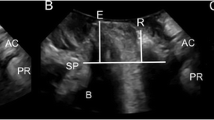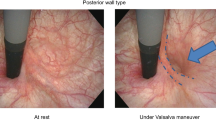Abstract
Background
Knowledge of risk factors is particularly useful to prevent or manage pelvic floor dysfunction but although a number of such factors have been proposed, results remain inconsistent. The purpose of this study was to evaluate the impact of aging on the incidence of posterior pelvic floor disorders in women with obstructed defecation syndrome evaluated using echodefecography.
Methods
A total of 334 patients with obstructed defecation were evaluated using echodefecography in order to quantify posterior pelvic floor dysfunction (rectocele, intussusception, mucosal prolapse, paradoxical contraction or non-relaxation of the puborectalis muscle, and grade III enterocele/sigmoidocele). Patients were grouped according to the age (Group I = patients up to 50 years of age; Group II = patients over 50 years of age) to evaluate the isolated and associated incidence of dysfunctions. To evaluate the relationship between dysfunction and age-related changes, patients were also stratified into decades.
Results
Group I included 196 patients and Group II included 138. The incidence of significant rectocele, intussusception, rectocele associated with intussusception, rectocele associated with mucosal prolapse and 3 associated disorders was higher in Group II, whereas anismus was more prevalent in Group I. The incidence of significant rectocele, intussusception, mucosal prolapse and grade III enterocele/sigmoidocele was found to increase with age. Conversely, anismus decreased with age.
Conclusions
Aging was shown to influence the incidence of posterior pelvic floor disorders (rectocele, intussusception, mucosa prolapse and enterocele/sigmoidocele), but not the incidence of anismus, in women with obstructed defecation syndrome.

Similar content being viewed by others
References
Hendrix SL, Clark A, Nygaard I, Aragaki A, Barnabei V, McTiernan A (2002) Pelvic organ prolapse in the women`s health initiative: gravity and gravidity. Am J Obstet Gynecol 186:1160–1166
Serati M, Salvatore S, Khullar V et al (2008) Prospective study to assess risk factors for pelvic floor dysfunction after delivery. Acta Obstet Gynecol Scand 87:313–318
Meyer S, Schreyer A, De Grandi P, Hohlfeld P (1998) The effects of birth on urinary continence mechanisms and other pelvic-floor characteristics. Obstet Gynecol 92:613–618
Dietz HP (2008) Prolapse worsens with age, doesn’t it? Aust NZ J Obstet Gynaecol 48:587–591
Soares FA, Regadas FS, Murad-Regadas SM et al (2009) Role of age, bowel function and parity on anorectocele pathogenesis according to cinedefecography and anal manometry evaluation. Colorectal Dis 11:947–950
Murad-Regadas SM, Regadas FSP, Rodrigues LV et al (2009) Types of pelvic floor dysfunctions in nulliparous, vaginal delivery, and cesarean section female patients with obstructed defecation syndrome identified by echodefecography. Int J Colorectal Dis 10:1227–1232
Murad-Regadas SM, Peterson TV, Pinto RA, Regadas FS, Sands DR, Wexner SD (2009) Defecographic pelvic floor abnormalities in constipated patients: does mode of delivery matter? Tech Coloproctol 13:279–283
Kepenekci I, Keskinkılıc B, Akınsu F et al (2011) Prevalence of pelvic floor disorders in the female population and the impact of age, mode of delivery, and parity. Dis Colon Rectum 54:85–94
Lienemann A, Anthuber C, Baron A, Kohz P, Reiser M (2004) Dynamic MR. Colpocystorectography assessing pelvic floor descent. Eur Radiol 7:1309–1317
Dvorkin LS, Hetzer F, Scott SM, Williams NS, Gedroyc W, Lunniss PJ (2004) Open magnet MR defaecography compared with evacuation proctography in the diagnosis and management of patients with rectal intussusception. Colorectal Dis 6:45–53
Barthet M, Portier F, Heyries L (2000) Dynamic anal endosonography may challenge defecography for assessing dynamic anorectal disorders: Results of a prospective pilot study. Endoscopy 32:300–305
Beer-Gabel M, Teshler M, Schechtman E, Zbar AP (2004) Dynamic transperineal ultrasound vs. defecography in patients with evacuatory difficulty: a pilot study. Int J Colorectal Dis 19:60–67
Dietz HP, Steensma AB (2005) Posterior compartment prolapse on two-dimensional and three-dimensional pelvic floor ultrasound: the distinction between true rectocele, perineal hypermobility and enterocele. Ultrasound Obstet Gynecol 26:73–77
Piloni V, Spazzafumo L (2005) Evacuation sonography. Tech Coloproctol 9:119–126
Murad-Regadas SM, Regadas FS, Rodrigues LV et al (2007) A novel procedure to assess anismus using three-dimensional dynamic anal ultrasonography. Colorectal Dis 9:159–165
Murad-Regadas SM, Regadas FS, Rodrigues LV, Silva FR, Soares FA, Escalante RD (2008) A novel three-dimensional dynamic anorectal ultrasonography technique (echodefecography) to assess obstructed defecation, a comparison with defecography. Surg Endosc 22:974–979
Regadas FSP, Lima Barreto RG, Murad-Regadas SM, Veras Rodrigues L, Pereira Oliveira LM (2012) Correlation between anorectocele with the anterior anal canal and anorectal junction anatomy using echodefecography. Tech Coloproctol 16:133–138
Agachan F, Pfeifer J, Wexner SD (1996) Defecography and proctography: results of 744 patients. Dis Colon Rectum 39:899–905
Felt-Bersma RJ, Luth WJ, Janssen JJ, Meuwissen SG (1990) Defecography in patients with anorectal disorders. Which findings are clinically relevant? Dis Colon Rectum 33:277–284
Kelvin FM, Hale DS, Maglinte DD, Patten BJ, Benson JT (1999) Female pelvic organ prolapse: diagnostic contribution of dynamic cystoproctography and comparison with physical examination. Am J Roentgenol 173:31–37
Marti MC, Roche B, Deléaval J (1999) Rectoceles: value of video-defecography in selection of treatment policy. Colorectal Dis 1:324–329
Chen HH, Iroatulam A, Alabaz O, Weiss EG, Nogueras JJ, Wexner SD (2001) Associations of defecography and physiologic findings in male patients with rectocele. Tech Coloproctol 5:157–161
Groenendijk AG, Birnie E, Boeckxstaens GE, Roovens JP, Bonsel GJ (2009) Anorectal function testing and anal endosonography in the diagnostic work-up of patients with primary pelvic organ prolapse. Gynecol Obstet Invest 67:187–194
Santoro GA, Wieczorek AP, Stankiewicz A, Wozniak MM, Bogusiewicz M, Rechbereger T (2009) High-resolution three dimensional endovaginal ultrasonography in the assessment of pelvic floor anatomy: a preliminary study. Int Urogynecol J 20:1213–1222
Dietz HP (2010) Pelvic floor ultrasound: a review. Am J Obstet Gynecol 202:321–334
Porter WE, Steele A, Walsh P, Kohli N, Karram MM (1999) The anatomic and functional outcomes of defect-specific rectocele repairs. Am J Obstet Gynecol 181:1353–1359
Thompson JR, Chen AH, Pettit PMD, Bridges MD (2002) Incidence of occult rectal prolapse in patients with clinical rectoceles and defecatory dysfunction. Am J Obstet Gynecol 187:1494–1500
Renzi A, Izzo D, Di Sarno G et al (2006) Cinedefecographic findings in patients with obstructed defection syndrome. A study in 420 cases. Minerva Chir 61:493–499
Rortveit G, Daltveit AK, Hannestad YS, Hunskaar S, Norwegian EPINCONT Study (2009) Urinary incontinence after vaginal delivery or cesarean section. N Engl J Med 348:900–907
Peschers UM, Schaer GN, DeLancey JO, Schuessler B (1997) Levator ani function before and after childbirth. Br J Obstet Gynaecol 104:1004–1008
Sultan AH, Kamm MA, Hudson CN, Thomas JM, Bartram CI (1993) Anal-sphincter disruption during vaginal delivery. N Engl J Med 329:1905–1911
Rieger N, Schloithe A, Saccone G, Wattchow D (1998) A prospective study of anal injury due to childbirth. Scand J Gastroenterol 33:950–955
Snooks SJ, Swash M, Mathers SE, Henry MM (1990) Effect of vaginal delivery on the pelvic floor: a 5-year follow-up. Br J Surg 77:1358–1360
Felt-Bersma RJF, Cuesta MA (2001) Rectal prolapse, rectal intussusception, rectocele and solitary rectal ulcer syndrome. Gastroenterol Clin North Am 30:199–222
Finco C, Luongo B, Savastano S, Polato F (2007) Selection criteria for surgery in patients with obstructed defecation, rectocele and anorectal prolapse. Chir Ital 59:513–520
Dietz HP, Clarke B (2005) Prevalence of rectocele in young nulliparous women. Aust N Z J Obstet Gynaecol 45:391–394
Wijffels NA, Collinson R, Cunningam C, Lindsey I (2010) What is the natural history on internal rectal prolapse? Colorectal Dis 12:822–830
Rociu E, Stoker J, Eijkemans MJ, Laméris JS (2000) Normal anal sphincter anatomy and age- and sex-related variations at high-spatial resolution endoanal MR imaging. Radiology 217:395–401
Goh J (2002) Biomechanical properties of prolapsed vaginal tissue in pre- and postmenopausal women. Int Urogynecol J 13:76–79
Wald A, Hinds JP, Caruana BJ (1989) Psychological and physiological characteristics of patients with severe idiopathic constipation. Gastroenterology 97:932–937
Stewart RB, Moore MT, Marks RG, Hall WE (1992) Correlates of constipation in an ambulatory elderly population. Am J Gastroenterol 87:859–864
Conflict of interest
The authors declare that no conflict of interest exists.
Author information
Authors and Affiliations
Corresponding author
Rights and permissions
About this article
Cite this article
Murad-Regadas, S.M., Rodrigues, L.V., Furtado, D.C. et al. The influence of age on posterior pelvic floor dysfunction in women with obstructed defecation syndrome. Tech Coloproctol 16, 227–232 (2012). https://doi.org/10.1007/s10151-012-0831-8
Received:
Accepted:
Published:
Issue Date:
DOI: https://doi.org/10.1007/s10151-012-0831-8




